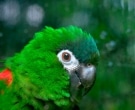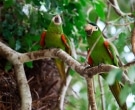30 cm.. length and a weight between 130 and 170 g..
The Red-shouldered Macaw (Diopsittaca nobilis) along with the other two subspecies belong to the Group of the small macaws often called dwarf macaws or mini macaws parrots.
They have forecrown, front of the crown and top of the eyes blue; rest of the head and upperparts, including the wings and the top of the tail, grass-green. Rojas the carpal joints and the leading edge of the wing . Lesser and medium underwing-coverts red; large underwing-coverts brown; underside of flight feather Golden olive.
The underparts green, but more yellowish than the upper. The bottom of the tail Golden olive.
Bill blackish; bare skin of the lores and top of the cheeks white; irises orange-brown; black legs.
Both sexes similar; Perhaps a little smaller females.
The immature with the head completely Green: has no red color in the carpal joints.
-
Diopsittaca nobilis cumanensis
(Lichtenstein, 1823) – Larger that the species nominal, at around 33 cm.. length. The forecrown more blue and the upper maxilla off-white.
-
Diopsittaca nobilis longipennis
(Neumann, 1931) – It is the largest subspecies, at around 35 cm.. length. Underparts more yellow and olive green
-
Diopsittaca nobilis nobilis
(Linnaeus, 1758) – The nominal
- Sound of the Red-shouldered Macaw.
With they are distributed in a variety of open wooded habitats, including savannah with scattered shrubs and palm trees (for example of Mauritia) in Suriname, morichales and the coast plantations in Guyana, closed with palm groves of Mauritia on the inside of Brazil and margins of caatinga in the northeast of Brazil with palm groves of Mauritia.
A persistent feature in its preferred habitat is the presence of Palm trees, especially of the genus M. flexuosa, Orbignya martiana and Maximiliana maripa (the latter especially in the southern region of the Amazon). Also observed in wetlands with palms, Gallery forests and cultivated areas.
Avoid large expanses of closed canopy forests, but can be seen around human settlements and is common in the city of Georgetown, Guyana.
They reach the 1.400 metres in Venezuela, to the South of the Orinoco.
Gregarious, often in large flocks outside breeding season; If not in couples.
Nest in tree cavities, termite tree or in holes of palmas. Copulations registered in the month of October to the South-West of Brazil; Probably engender between February and June in Guiana. Clutch four eggs in captivity. The average period of incubation is of 24 days, the chicks leave the nest about 54 days after birth.
Its diet, probably, It is similar to its closest relatives, nuts are included in the, seeds, fruits and flowers, but with some signs of favorite seeds; known his preference for flowers of Terminalia argentea and Erythrina glauca, as well as the berries Cordia and fruits Euterpe. They also feed cereals and fruits in cultivated fields and are considered as one plague in some areas.
Tamaño del área de distribución (reproducción/residente): 910.000 km2
Endemic to the northeast of South America, from the East of the Andes toward the center of Brazil.
In East Venezuela they are distributed, mainly, to the South of the Orinoco (Delta Amacuro and parts of Bolivar), also at the East end of Monagas.
The few records of Trinidad they are probably elopements captive birds.
Are distributed through of the Guianas, in areas of seasonal forests (mainly near the coast) and in Brazil to the North of the Amazon in Roraima, Amapá and North of For. Returns disjoint inside of Brazil, to the South of the Amazon from the southeast of For and Maranhão the wetlands of Mato Grosso and to the South by the dry northeast in Piauí, Bahia and, According to reports in the South of Alagoas until Espírito Santo, Rio de Janeiro and Northwest of São Paulo (with a population introduced in the City of São Paulo).
They occupy the Center and East of Bolivia and Southeast of Peru, where there are records in the Heath pampas.
In general residents, with seasonal movements in some coastal areas (for example Guianas) and distributed irregularly, to the North of Amazon, where they remain scattered on the basis of suitable habitat.
In general common, especially in the Centre and northeast of Brazil, Although rare in the Guianas.
-
Diopsittaca nobilis cumanensis
(Lichtenstein, 1823) – Northwest of Brazil, to the South of the Amazon River, from Alagoas and West of Bay until Maranhão and Southeast of For, and South to the Centre of Goiás.
-
Diopsittaca nobilis longipennis
(Neumann, 1931) – Inside of Brazil, from the center of Goiás and West of Minas Gerais, Brazil to the Northwest of São Paulo and Mato Grosso, spreading Southeast of Peru to the East and centre of Bolivia; introduced in the City of São Paulo.
-
Diopsittaca nobilis nobilis
(Linnaeus, 1758) – The nominal
• Red list category of the UICN current: Least concern
• Population trend: Stable
Global population size has not been quantified, but this species is described as “quite common” (Stotz et to the., 1996).
The population of Red-shouldered Macaw suspected to be stable in the absence of evidence of any reduction or substantial threats.
Currently capture and trade of wild individuals is illegal.
Fairly common.
They are the smaller macaws commercially available pet and enough popular due to its small size (only a little bigger that a cockatoo) and for its excellent ability to imitate sounds.
In captivity, These birds are sociable and friendly.
The Red-shouldered Macaw they are easy to breed in captivity birds. They have proven to be prolific players and they have brought successfully for many years. In his book “All about parrots“, the author Arthur Freud He points out that the first Red-shouldered Macaw It was bred in captivity in the United Statess in the year 1939 and again in 1940, the Lord and Lady Vance Wright. But it was the British success during the year 1949 by EMT Vane, the best known. In fact Vane He received the first breeding metal from the British Avicultural Society ’ s for his achievements with the Red-shouldered Macaw.
The Red-shouldered Macaw they are commonly kept as pets, but their number has been decreasing in nature due to the habitat destruction and to his capture to the pet market.
With regard to its longevity, According to sources, It is known that a specimen lived 22,9 years in captivity.
- Red-shouldered Macaw, Hahn's Macaw, Long-winged Macaw, Neumann's Macaw, Red shouldered Macaw (inglés).
- Ara noble (francés).
- Zwergara (alemán).
- Maracanã-pequena, arara-nanica, maracanã, maracanã-nobre (portugués).
- Cotorra Serrana Occidental, Guacamayo Noble, Maracaná Menor, Guacamaya de hombros rojos (español).
- Guacamayo Enano (Perú).
- Guacamayo Enano (Venezuela).

- Orden: Psittaciformes
- Familia: Psittacidae
- Genus: Diopsittaca
- Nombre científico: Diopsittaca nobilis
- Citation: (Linnaeus, 1758)
- Protónimo: Psittacus nobilis
————————————————————————————————
Red-shouldered Macaw (Diopsittaca nobilis)
Sources:
– Avibase
– Parrots of the World – Forshaw Joseph M
– Parrots A Guide to the Parrots of the World – Tony Juniper & Mike Parr
– Birdlife
– Photos:
(1) – A Red-shouldered Macaw at Parque das Aves, Foz do Iguaçu, Brazil. This subspecies is also know at the Noble Macaw By Chad Bordes (Picasa Web Albums) [CC BY 3.0], via Wikimedia Commons
(2) – The photograph shows a Hahn’s Macaw (D. n. nobilis) pet parrot perching on a finger By derivative work: Snowmanradio (talk)Diopsittaca_nobilis_-pet-2.jpg:Evenprime at en.wikipedia. Photo by Walter Maier. Picture of family pet. Later version(s) were uploaded by Snowmanradio at en.wikipedia. (Diopsittaca_nobilis_-pet-2.jpg) [GFDL or CC-BY-SA-3.0], from Wikimedia Commons
(3) – Two Red-shouldered Macaws in the Pantanal, Mato Grosso, Brazil By Nori Almeida (originally posted to Flickr as Pantanal 2009) [CC BY 2.0], via Wikimedia Commons
(4) – Long-wing Macaw or Hahn’s Macaw); two in a cage By TJ Lin (originally posted to Flickr as DSCN9927) [CC BY-SA 2.0], via Wikimedia Commons
(5) – Two Red-shouldered Parrots at Lisbon Zoo, Portugal By Jorge Andrade from Rio de Janeiro, Brazil (Lisbon zoo (107)Uploaded by snowmanradio) [CC BY 2.0], via Wikimedia Commons
(6) – Red-shouldered Macaw (Diopsittaca nobilis), also known as the Noble Macaw By Snowmanradio (Own work) [CC BY-SA 3.0 or GFDL], via Wikimedia Commons
(7) – A Red-shouldered Macaw at Bird Park, Kaluga region, Zhukovsky District, Russia By Remiz [CC BY-SA 2.0], via Wikimedia Commons
(8) – Three Red-shouldered Macaws at a zoo By DSuàr (To be coldUploaded by Snowmanradio) [CC BY-SA 2.0], via Wikimedia Commons
(9) – Red-shouldered Macaw (this subspecies is also known as Hahn’s Macaw) at Jungle Island, Miami, USA By Chris Acuna from Miami, USA [CC BY 2.0], via Wikimedia Commons
– Sounds: (Xeno-canto)









